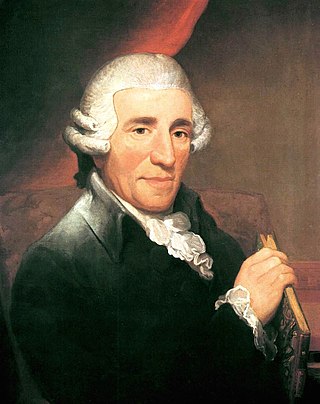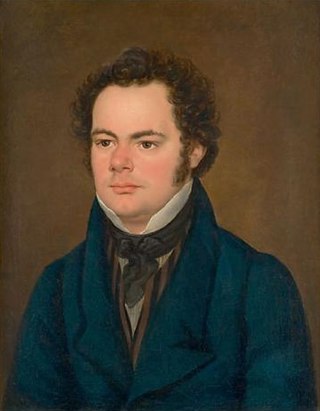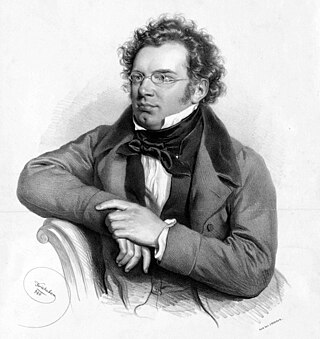Related Research Articles
The sonata form is a musical structure generally consisting of three main sections: an exposition, a development, and a recapitulation. It has been used widely since the middle of the 18th century.
The Piano Sonata No. 16 in C major, K. 545, by Wolfgang Amadeus Mozart was described by Mozart in his own thematic catalogue as "for beginners", and it is very commonly known by the nickname Sonata facile or Sonata semplice.

Ludwig van Beethoven's Piano Sonata No. 8 in C minor, Op. 13, commonly known as Sonata Pathétique, was written in 1798 when the composer was 27 years old and was published in 1799. It has remained one of his most celebrated compositions. Beethoven dedicated the work to his friend Prince Karl von Lichnowsky. Although commonly thought to be one of the few works to be named by the composer himself, it was actually named Grande sonate pathétique by the publisher, who was impressed by the sonata's tragic sonorities.
The Piano Quintet in F minor, Op. 34, by Johannes Brahms was completed during the summer of 1864 and published in 1865. It was dedicated to Her Royal Highness Princess Anna of Hesse. As with most piano quintets composed after Robert Schumann's Piano Quintet (1842), it is written for piano and string quartet.

The Symphony No. 104 in D major is Joseph Haydn's final symphony. It is the last of the twelve London symphonies, and is known as the London Symphony. In Germany it is commonly known as the Salomon Symphony after Johann Peter Salomon, who arranged Haydn's two tours of London, even though it is one of three of the last twelve symphonies written for Viotti's Opera Concerts, rather than for Salomon.

Ludwig van Beethoven's Piano Sonata No. 6 in F major, Op. 10, No. 2, was dedicated to the Countess Anne Margarete von Browne, and written from 1796 to 1798. It was published in Vienna by Joseph Eder in 1798.

Ludwig van Beethoven's Piano Sonata No. 22 in F major, Op. 54, was written in 1804. It is contemporary to the first sketches of the Symphony No. 5 in C Minor. It is one of Beethoven's lesser known sonatas, overshadowed by its widely known neighbours, the Waldstein and the Appassionata.
Cello Sonatas No. 1 and No. 2, Op. 5, are two sonatas for cello and piano written by Ludwig van Beethoven in 1796, while he was in Berlin. While there, Beethoven met the King of Prussia Friedrich Wilhelm II, an ardent music-lover and keen cellist. Although the sonatas are dedicated to Friedrich Wilhelm II, Ferdinand Ries tells us that Beethoven "played several times at the court, where he also played the two cello sonatas, opus 5, composed for Duport and himself". Although Jean-Pierre Duport was one of the King's teachers, it is now thought to have been his brother Jean-Louis Duport who had the honor of premiering these sonatas.

Schubert's Symphony No. 10 in D major, D 936A, is an unfinished work that survives in a piano sketch. Written during the last weeks of the composer's short life, it was only properly identified in the 1970s. It has been orchestrated by Brian Newbould in a completion that has subsequently been performed, published and recorded.
The Piano Sonata in A minor D. 845 (Op.42) by Franz Schubert is a sonata for solo piano. Composed in May 1825 and entitled Premiere Grande Sonata, it is the first of three sonatas published during the composer's lifetime, the others being D.850 and D.894. Conceived as a set, these works were composed during what was reportedly a period of relatively good health and spirits for Schubert and are praised for their quality and ambition. This first sonata in particular marks a significant step toward the composer’s mature piano sonata style; the format and several characteristic stylistic elements continue through the last.
The Piano Sonata in E-flat major D 568 by Franz Schubert is a sonata for solo piano. It is a revision and completion of the Sonata in D-flat major D 568. The D-flat major version was composed in June 1817, while the E-flat major revision and completion, published in 1829 after Schubert's death as Op. posth. 122, dates from sometime around 1826.

Wolfgang Amadeus Mozart's Piano Sonata No. 10 in C major, K. 330 / 300h, is one of the three works in the cycle of piano sonatas K.330-331-332. The sonata was composed in 1783, when Mozart was 27 years old. It was published, with the other two sonatas by Artaria in 1784. A typical performance of this sonata lasts around twenty minutes.
Piano Sonata No. 2, Op. 36, is a piano sonata in B-flat minor composed by Sergei Rachmaninoff in 1913, who revised it in 1931, with the note, "The new version, revised and reduced by author."
Franz Schubert's Piano Sonata in A minor, D 784, is one of Schubert's major compositions for the piano. Schubert composed the work in February 1823, perhaps as a response to his illness the year before. It was however not published until 1839, eleven years after his death. It was given the opus number 143 and a dedication to Felix Mendelssohn by its publishers. The D 784 sonata, Schubert's last to be in three movements, is seen by many to herald a new era in Schubert's output for the piano, and to be a profound and sometimes almost obsessively tragic work.
Franz Schubert's Piano Sonata in C major, D. 840, nicknamed "Reliquie" upon its first publication in 1861 in the mistaken belief that it had been Schubert's last work, was written in April 1825, whilst the composer was also working on the A minor sonata, D. 845 in tandem. Schubert abandoned the C major sonata, and only the first two movements were fully completed, with the trio section of the third movement also written in full. The minuet section of the third movement is incomplete and contains unusual harmonic changes, which suggests it was there Schubert had become disillusioned and abandoned the movement and later the sonata. The final fourth movement is also incomplete, ending abruptly after 272 measures.

The Piano Sonata in A major, D 664, Op. posth. 120, is a sonata for solo piano composed by Franz Schubert in the summer of 1819.
The Piano Sonata in E major, D 459, is a work for solo piano, composed by Franz Schubert in August 1816. It was first published in 1843, after the composer's death, by Carl August Klemm in Leipzig, in a publication known as Fünf Klavierstücke.

Franz Schubert's last three piano sonatas, D 958, 959 and 960, are his last major compositions for solo piano. They were written during the last months of his life, between the spring and autumn of 1828, but were not published until about ten years after his death, in 1838–39. Like the rest of Schubert's piano sonatas, they were mostly neglected in the 19th century. By the late 20th century, however, public and critical opinion had changed, and these sonatas are now considered among the most important of the composer's mature masterpieces. They are part of the core piano repertoire, appearing regularly on concert programs and recordings.

Wolfgang Amadeus Mozart's Piano Sonata No. 1 in C major, K. 279 / 189d (1774), is a piano sonata in three movements. Except for the first part of the opening movement, it was written during the visit Mozart paid to Munich for the production of La finta giardiniera from December 1774 to March 1775. Although Mozart is known to have written at least five other solo piano sonatas in his youth, K.279 is the first of his 18 extant solo piano sonatas. A typical performance of the sonata takes about 14 minutes.
The Piano Sonata in B major D 575 by Franz Schubert is a sonata for solo piano, posthumously published as Op. 147 and given a dedication to Sigismond Thalberg by its publishers. Schubert composed the sonata in August 1817.
References
- Tirimo, Martino. Schubert: The Complete Piano Sonatas. Vienna: Wiener Urtext Edition, 1997.